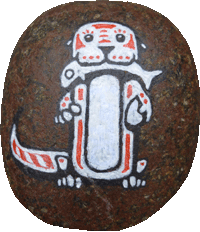Written by Maureen
We went on two treks in Nepal. The first was a five day Poon Hill trek in the Annapurna region. The second trek was ten days combining Langtang with Gosaikund lake, although we actually snubbed the holy lake and instead spent a day searching for red panda, musk deer and other wildlife in the high-altitude forests around Sing Gompa (we saw nowt).
Due to time constraints, we arranged the treks through a Kathmandu-based agency – Responsible Adventures. They arranged all transportations, permits and provided us with guides and porters. Using an agency, we could be confident that the staff were provided with proper equipment, training and insurance.
Before we came, we had no real idea of what to expect on a teahouse trek. I hope that this summary, based on our personal experience and hard-won knowledge, may be useful if you are considering doing one.
Fitness
Guides and porters
If you’re super-fit, you may choose to carry your own stuff, but we would recommend hiring a porter. You will (probably) enjoy the trek more and be able to cover more ground every day. You can secure the services of a porter fairly easily in town, or at any location along your route. Alternatively, use an agency – they will ensure that your porter is well equipped and is properly insured. Either way, please don’t overload him – 25kg per porter max! Leave what you don’t need in your hotel in Kathmandu or Pokhara.
The main teahouse trekking routes (Annapurna, Langtang, Everest) are well-trodden and you are unlikely to get lost, so you would be fine without a guide. However, a good guide can help you find nice lodges, facilitate communication with lodge owners and come in useful in an emergency. If you’re lucky, your guide will be knowledgeable, informative and good company too. But beware! Not all guides are created equal.
Our Poon Hill guide was excellent and very patient under trying circumstances. Our Langtang guide, on the other hand, was opinionated, loud, uninformative and insensitive. On the fouth day of our trek, the weather turned and caught us inadequately dressed. Skipping ahead, our guide seemed completely unaware that his trekkers were suffering from exhaustion and extreme cold. When I mentioned that I had lost the use of my fingers which had began to resemble boiled frankfurters, he replied with typical sympathy, “we all have swollen fingers, not just you”. When we eventually made it to our lodge, I crawled into my sleeping bag without dinner and stayed there for fourteen hours, frozen and utterly miserable. Next morning our guide didn’t even bother to ask how I was.
If you’re looking for a guide, I suggest seeking out a personal recommendation – get in touch if you want ours. Alternatively check out a relevant forum such as trekinfo.com or thorntree.lonelyplanet.com. They also contain other useful information such as how much you should be paying for a guide or porter.
Gear
Sleeping bags are a must! Most beds come with a mattress, mattress-cover and pillow. Notice I didn’t say blanket, though you can probably borrow one from the lodge owner. We hired a four-season sleeping bag (R60 per night in Pokhara). Lots of places hire out trekking gear and your guesthouse owner or guide should be able to recommend one – make sure to sniff and check for cleanliness. It’s worth bringing your own sleeping bag liner for extra warmth and a soupcon of hygiene.
We also hired heavy-duty down jackets (R45 per night). I bought a woolly hat and a pair of thick gloves (R400 total in Kathmandu). I recommend bringing a couple of fleeces – my light-weight technical garments were, in hindsight, woefully inadequate for keeping me warm.
You will need a daypack to carry the stuff you’ll need during the day (loo roll, snacks, extra layer, rain gear, trek towel, water, sun cream, lip balm). We also carried a basic first-aid kit in ours.
Most people trek in proper hiking boots with ankle support and trekking poles. We managed with our everyday walking shoes which, after four-months of continuous wear are well worn in and blister free.
Absolutely vital, bring a head-torch. Many lodge rooms don’t have electricity and I wouldn’t recommend walking to the outside privy in the dark either. Also important are hand sanitiser (some lodges don’t have water near the toilet), and a small mirror if checking your face every now and then is important to you, and particularly if you wear contact lenses.
Lodges
The best lodge we stayed in had a (shared) indoor toilet, a hot shower, electricity, a warm dining room and excellent food. The worst had none of the above. Well, it claimed a shower but we didn’t try since that involved balancing over the squat toilet to use it. Be warned: very few lodges come with western-style thrones and fewer still regard the washbasin as a basic necessity of life. You wash your face and clean your teeth with freezing cold water from the outside tap.
But even the reasonably nice lodges are “shonky unfinished DIY projects” (Matt’s verdict). The flimsy walls might just about keep your room on the right side of freezing, but they won’t keep out a) noises such as whispering and snoring, b) unwanted furry guests – one scampered over our sleeping bags in the middle of the night.
In the popular trekking routes, the nicer lodges get full quickly during peak season (autumn, spring). Worst scenario: you might end up sleeping in the dining room, or sharing a room with strangers. So either get to your destination early (especially if you want to use the limited hot water supply for a shower) or persuade your guide to call or send a porter ahead to book a room. This worked a treat in Poon Hill. Our Langtang guide, however, preferred to delegate to us when it came to choosing a lodge, which was why we ended up staying in some crappy ones.
If you’re trekking independently, you may get hassle from agents trying to persuade you to stay in their lodge – don’t listen to them! Check out rooms for yourself.
Expect to spend R200-R400 for a room, and approx R1000pp per day on food. You are expected to eat dinner at the lodge, otherwise there is an extra charge for the room. Food is variable. The wacky thing is, the National Park authority for each region has designed a standard menu for every lodge to offer. This means that even the most basic lodge is forced to offer vegetable lasagne, for example. What is actually served will depend on available ingredients and the cook’s interpretation, but is unlikely to bear much resemblance to something you might find in an English pub or Italian restaurant. My advice is, avoid the fancy dishes.
Responsible trekking
Litter is a real problem, even in the mountains. Many lodges now provide litter bins, but people still throw their rubbish anywhere. I suspect that locals, porters and tourists are equally guilty. Needless to say, take your litter with you, and filter water rather than add to the plastic bottle mountain.
I got very angry at the way animals were treated here. Many of the pack ponies in Annapurna were in a sad condition and suffering from open wounds as a result of insufficient padding from their burden. We saw one mule driver beat his ponies with a heavy stick. Children routinely threw large stones at dogs, birds and other animals. Grrrr. Turn a blind eye, or risk a confrontation with the locals?
Would I do it again?
No, thanks.
The days could be wonderful. Splendid snow-capped mountains, icy streams winding between sheer valley walls, magical mossy forests, russet colours of an alpine autumn, terraces of wheat laid out before a traditional Nepalese village – these are good reasons to come trekking in Nepal.
But for me they couldn’t compensate for freezing cold nights in comfortless rooms with miserable shared ablution facilities which greeted the end of every day. Try sleeping in your fridge for ten consecutive nights and you get the idea.
Everyone we spoke to claimed to have enjoyed their trek; some have been coming back year after year. So now that you know what to expect, why not give it a try? I really hope you enjoy it more than I did.
Some general tips
Bring a water filtration system. Not only is it better for the environment, but you’ll find bottled water prices also climb as you climb higher
Route Summary
| Poon Hill | Langtang/Gosaikund | |
| Duration | 5 days | 10 days |
| Hours walking (pace) | 32 (slow) | 50 (very fast) |
| Level of difficulty | Moderate | Moderate/strenuous |
| Terrain | Terraced farm valleys, forests | Forests, high pastures |
| Facilities | Basic to decent lodges | Basic lodges |
| Comments | Though shorter, there are a lot of steep climbs and descents | The hard climbs are on the Gosaikund part of the trek |
Related Images:















































Hi guys, pleased to have you back safe and sound on your blog!
Brrrr! Just reading about how cold you were overnight in your Lodges makes me shiver. The weather in the UK has got pretty nippy, but at least we can look forward to snuggling in our cosy warm beds at night.
Your Langtang guide sounded like a right knob head – shame you had him for the longer trek.
So when are you heading to sunnier climates? Bet you cannot wait now!
Things are all good at our end. We are looking forward to the Ludlow Medieval Xmas Fayre at the end of the month. I will think of you guys while i’m enjoying lunch at La Becasse! Although I bet you guys are going to have some fantastic meals during your travels . . .
Anyway, best be off.
Missing you both.
Take care,
Hels xx
Well, we’re off to Thailand on a flight tonight – sunnier climates here we come! Though I don’t think even the Thai food will quite match La Becasse (or the Green Cafe down at the bottom of Dinham – don’t forget to go there for lunch sometimes).
Looks like you are having a fab time. Makes wonderful reading. Keep blogging and take care.
By the way my kids enjoy the wildlife pics on a daily basis.. they can’t get enough of them, specially my younger one.
Oops! So I should avoid expletives in future! Anyway, it’s great to know you’re enjoying the blog. I’d be really interested to hear if there’s any particular wildlife photo that was a favourite.
Oh, and if you want to drop me an email I’d also love to hear how things are at Hewitt these days!